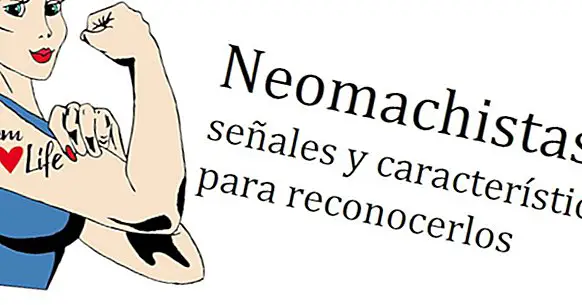Neomachists: 7 signs and characteristics to recognize them
Thanks to initiatives in favor of feminism today, women in many countries can enjoy conditions of equality that would have been inconceivable decades ago.
However, machismo continues to be deeply rooted in all types of cultures and societies, which means that many prejudices and ideas still weigh heavily, leading to the undervaluation of women. In Western countries open machismo and traditionally vindicated publicly has largely disappeared, but there is still a remnant: the neomachism and, particularly, People with neo-Chauvinist attitudes .
What is a neomachist?
A neomachist is, in short, a person who believes in the inferiority of women or that they deserve less the appellation of "human beings" than men, but that it tries to make this system of ideas concealed. In other words, neomachist people reproduce to a greater or lesser degree the ideas linked to machismo, but reformulating certain presuppositions and arguments so that they are more subtle.
Neomachism, like machismo, is not based on hatred of women, as it happens where there is misogyny. It is based, simply and plainly, on the contempt and the defense of the idea that being a woman always implies having less value as a person with interests, motivations and own criteria . Neomachist people will express these ideas indirectly, avoiding certain acts and phrases that are considered politically incorrect by the majority of the population.
Recommended reading: "Psychology of sexism: 5 macho ideas that occur today"Characteristics of neomachism
That is why recognizing a neomachist is not as simple as doing the same with someone clearly macho. However, that does not mean it is not impossible to do so.
Next I propose some basic characteristics that the neomachist can present, not only to criminalize the people prone to fall into these attitudes, but to be able to take into account that those ideas are still alive although it may not seem so at first sight.
1. Systematic condescension
One of the great paradoxes of neomachism is that can be expressed through seemingly advantageous treatment of women . But it is not a friendly treatment based on individual love towards a person who happens to be a woman, but is based on the idea that women have the social status of children that due to their lack of maturity should be protected and oriented in his life.
In this sense, a very present attitude in neomachism is to treat almost all women, in a systematic way, as if they were little more responsible for their lives and personal decisions than a child.
2. Elegant defense of traditional values
Neomachist people do not explicitly defend the legitimacy of man's power over women or the domination by force of the former over the latter, but yes they can show longing for the traditional values on which decades ago this type of behavior was based . For example, they can show a romantic vision of the lover who protects her lover from danger and at the same time controls her so that it does not become the possession of another man. You can also claim more or less veiled the ideal of the pure woman who only lives for her partner, which implies that women who do not conform to this stereotype are impure.
It is a defense of traditional values that are attempted asocial to the elegant and good morals, morally correct and "natural". In this way, the neomachist denies the possibility of questioning these ideas and beliefs by leaning on a dogmatism based on what has been done for centuries.
3. Recurrent comments on the physique of women
Neomachist people, regardless of their sex, tend to make more comments about the physique of women than about the appearance of men .
These may be phrases that fit the theme of a conversation that was in progress or may be isolated comments, and may be addressed to the woman she is talking about or to other people. The fact is that from neomachism the appearance of the woman acquires special importance, being related to the reproductive value of the woman.
4. Constant references to the reproductive role of women
An important part of the work on gender studies and feminist anthropology point out the link that exists in the West between women and the domestic environment. Traditionally, in European societies the role of women has been confined to the domestic while man, in addition to sending in his home, has unlimited access to the public sphere of society.Thus, the idea has been proposed that if the male role is to produce goods and services that will provide for the family, the woman has traditionally dealt with reproduction.
Thus, while the role of man can not be reduced to only one of his attributes, that of the woman itself could be reduced to the parts of her body that have a direct role in reproduction and nurturing . Although in Western countries the sphere of women is no longer just the domestic sphere (the number of university students and qualified professionals has grown a lot), remnants of this value system remain in the form of neomachism where it is taken for granted, for example, that the destiny of every woman is to be a mother, or where it is assumed that the professional or financial success of a woman is linked to her capacity to attract men.
5. Continuous references to the feminine nature
If the differences between men and women are the cause of culture and education or genetic inheritance is a subject of intense debate in scientific circles and there is no clear answer. However, neomachist people will show a bias towards the position that all gender roles associated with the feminine are produced by biological differences that can not be avoided and that largely determine the behavior of both sexes, although today this radical and deterministic position has little or no basis.
Of course, the supposedly "natural" female behavior that is defended from neomachism is more related to submission and domestic tasks and simpler than those of men, traditionally responsible for making the most important decisions and for ruling over the rest of the family members.
6. Criticisms of female leadership
Seeing women in high positions or in positions associated with a great power of decision fits poorly with the traditional feminine ideal. Therefore, people prone to fall into neomachism They will show great sensitivity to errors or characteristics perceived as negative that these women can show , however insignificant they may be.
The very fact of being a woman with a high responsibility can be a reason for criticism if it is understood that she only does her job "to be able to command". This bias will not exist when assessing the work of male leaders.
7. The compliments are always welcome
From the conservative perspective of a neomachist, women always appreciate compliments if they are elegant and inspired enough.
Of course, this is not the case, because if it were true, the level of complexity of the women's psyche would be drastically reduced. But nevertheless, Neomachism emphasizes the way in which the mentality of women can fit with the stereotypes of the feminine that the ability of these people to think and act released from these bonds.
Side note: criticism of feminism
There are political motivations that lead to try to relate the criticism of feminism (or even the use of words such as "feminazi") with machismo.
However, this could only have a basis if, as feminism, we understand, simply, the vindication of the idea that men and women have the same value as human beings. The problem, and what makes someone criticizing feminism need not present the typical characteristics of someone who holds macho ideas and beliefs, is that feminism does not have to stick to this definition so lax , especially since it is understood that there is not only one feminism but several.
The new feminisms are a set of social movements and theories that fight for the recognition of women as human beings and / or for making women have the same rights and possibilities as men. There is no common goal in these movements or a single way of understanding the inequality between sexes and genders, and many feminisms have points that are totally opposite to each other. The only thing that all the new feminisms have in common is that:
1. They point out the inadequacy of basing equality between the sexes in the use of laws that do not discriminate against women.
2. They defy the traditional belief system and values of the West in relation to love relationships, marriage or gender roles. Part of the battle that new feminisms wage is cultural.
People who reproduce Neomachist ways of thinking have reasons to try to discredit all feminisms based on the second of the characteristics shared by all the new feminisms, which is against the essentially macho idea that women are predestined to fulfill a role of subordination.
In these critiques there will be no place for nuances that exist feminisms, and all that can be related to feminism as a unit will be negatively pointed out , because as a set of political and social movements it can threaten the traditional value system.
Some limitations
However, this point, as a defining characteristic of people who reproduce a Neomachist way of thinking and acting, has an important limitation: it is not easy to know if the criticisms of feminisms as a whole are based on the second characteristic shared by these currents. of thought, or if they attack only the first.
Non-conservative or sexist people could make very elaborate and solid criticisms based simply on the assumption of the overreaching of the new feminisms.
Conclusions
This small list of characteristics is not one that allows identifying people prone to neomachism in a matter of seconds.
Machismo does not consist in the repetition of stereotypical phrases and actions, but rather is expressed depending on the specific context in which the person is . That is why to see if these indicators fit with the behavior of someone is necessary to take into account several factors and assess the existence of alternative explanations.
Bibliographic references:
- Brescoll, V. L. (2012). Who takes the floor and why: Gender, power, and volubility in organizations.Administrative Science Quarterly. 56 (4), pp. 622-641.
- Molina Petit, C. (1994). Feminist Dialectic of the Enlightenment. Barcelona: Anthropos.



















